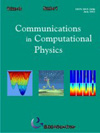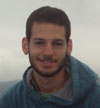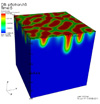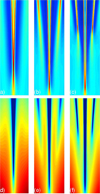 |
Undergraduate Best Poster Award:
Quinn Wenning won the
Undergraduate Best Poster Award at
the
1st Annual Jackson School Research Symposium, for his
project Characterizing Reactive Flow Paths in Fractured Cement
with
PhD student Nicolas Huerta. |
 |
12/18/2011: 100-th citation
Marc's first PhD paper is cited 100 times. The work with Amir Riaz, at the time postdoc at
Stanford, and my advisors Hamdi Tchelepi and Lynn Orr looks at the stability of a
gravitationally unstable diffusive boundary layer. A theoretical analysis of the classic
Elder problem in porous media convection. |
 |
Undergraduate research fellowship competition
Quinn Wenning won a $1000 a Spring 2012 Undergraduate
Research Fellowship for his project on reactive flow on in
cement fractures with PhD student Nicolas Huerta. |
 |
Cover art: Communications in Computational Physics
The cover of for volume 10, number 1 of Communications in
Computational Physics features a simulation from our article
Modelling magma
dynamics with a mixed Fourier collocation - discontinuous Galerkin
method co-authored with Dr. Alan Schiemenz (LMU
Munich) and Prof. Jan Hesthaven (Brown).
The image, shown on the right, shows the localization of the
melt flow due to reactive feedback in the top row and the
orthopyroxene abundance in the mantle in the lower row. |
 |
Abraham Taicher receives NIMS Fellowship 2011-2012
PhD student Abraham Taicher has received the 2011-2012 National Initiative
for Modeling and Simulations Fellowship from the CSEM graduate program. |
 |
15-16/08/11: Reactive Flow Summer School
by Peter Lichtner (LANL) and Glenn Hammond (PNNL)
This shortcourse will provide a hands-on introduction to
PFLOTRAN, a massively parallel
subsurface reactive flow and transport computer code that
runs on labtops to high-end supercomputers. The code
includes Richards equation for variably saturated media,
two-phase CO2-H2O, and
thermal-hydrologic-chemical (THC) modes coupled to reactive
transport in multicomponent systems. |
 |
5/3/11: Austin Statesman features JSG Explore UT experiment
With great support from the Jackson School Marc Hesse and
Kelly Quinney built a large version of the famous cornstarch
& water experiment for Explore UT. The experiment demonstrates
shear thickening behavior and allows you to "walk on
water". It was a big success and more than 500 children
walked the walk. |
 |
Kyung-won wins
AAPG - Allan & Eleanor Martini Grant
Kyung-won
Chang received the grant to study buoyancy driven exchange
flows at the BP-Institute. He developed a technique to
quantify the exchange flow and is now using it to constrain
leakage rates along permeable conduits and the role of
hydro-mechanical dispersion in counter current flows. |
 |
12/8/10:
GRL editor’s highlight: Characterizing channels for transport of melt in mantle
To investigate how dunite channels would form and how melt would flow through them in an
upwelling mantle, Liang et al. (2010) conducted numerical simulations. They found that
interconnected dunite channels form the shallow part of the porous channels through which
melt passes; deeper in the mantle, melt travels through channels composed of the rocks
harzburgite and lherzolite. These results could help geologists interpret field measurements
and improve models for mantle melt migration, shedding light on mantle dynamics and crust
formation.
Liang, Y., A. Schiemenz, M. A. Hesse,
E. M. Parmentier, and J. S. Hesthaven (2010), High-porosity
channels for melt migration in the mantle: Top is the dunite
and bottom is the harzburgite and lherzolite, Geophys. Res.
Lett., 37, L15306, doi:10.1029/2010GL044162.
|